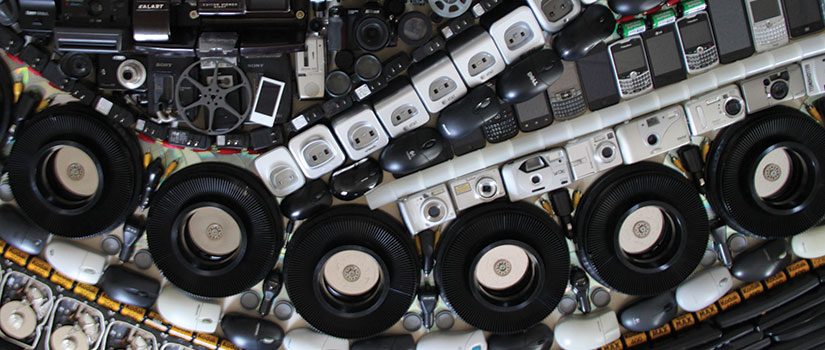Posted March 15, 2017
Story and photos by Tori McAnallen, Reprinted from InterCom
During the 2016 fall semester, two custom 3D art pieces created for the School of Journalism and Mass Communications were installed at the school’s Sumter Street entrances.
Dr. Andrea Tanner, the SJMC Director, initiated this project by reaching out to faculty, working with their visions of the empty, encased space. “What we are trying to accomplish is not just hanging things on every wall. What we put in place, we want to be meaningful,” Dr. Tanner explained.
The communal concept and image of structures coming from the walls was realized. Dr. Tanner turned to Rhonda Douglas, owner of Douglas Art Consulting, to find the right artists for the job.
The search narrowed to two South Carolina artists: Kirkland Smith, based in Columbia, and Jose Perez from Taylors. Smith and Perez were chosen based on their remarkable work in large-scale 3D art and understanding of the school’s vision. When walking past the two entrances, you will see a message rooted in mass communications and journalism.
“Everybody has been extremely happy with the art ... it looks like it has always been there and is always meant to be there,” said Dr. Tanner
About the Art
Kirkland Smith - Convergence
“Convergence” is the title of Kirkland Smith’s installation that strikes viewers as a wave through our technological past in communications. From a distance, it is full of movement and flow, like an orderly painting. However, when seen closer, pieces of televisions, phones, film, microphones, slide projectors and reels come out from the wall, creating a more chaotic perspective.
“A lot of the things I use are everyday household objects that people use, consume, and throw away.” she said. “Most of it goes to the landfill and isn’t recyclable.”
Smith is a local artist and graduate of USC’s School of Visual Arts and Design. She is noted for her assemblage portrait art, made entirely out of objects. Those objects work as her medium, compiled through color, tone and values to create portraits or an entirely new image.
Smith began her “Convergence” piece by asking faculty for donations, and was inundated with boxes of older technology and memorabilia.
“I was really touched and impressed by the level of participation,” she said. “That makes it so much more fun; I feel like I am only as good as my trash.”
“Convergence” can be interpreted as a visual time capsule for those involved in the project and the mass communications industry.
With some of the objects found in her structure previously belonging to faculty, Smith appreciates the urge to collect and hold onto these things with meaningful value. “I think that what we throw away says a lot about who we are, but I think the things we choose to cherish and protect say more,” Smith said.
Jose Perez - Cultural Influencers
Jose Perez’s installation is composed of 10 wooden panels, painted and constructed to form multi-dimensional graphic imagery. “Cultural Infuencers” shares the story of technology and mass communication’s evolution through the last 100 years. Each decade is represented in a panel, with the significant technological advancement of that time illustrated.
While the art appears abstract at an angle, with height variation and overlapping panels, it becomes whole when viewed from the front. Imagery of USC comes into focus, including Cocky and the hashtag #SJMC, making this piece distinctive to the school. Additional personal touches include specific colors that Perez worked with. He was given paint chips from the SJMC building, to match the walls and furniture, including the official garnet of USC.
The relevance and evolution of the technology in his structure is something that fascinates Perez, who observed the way we evolve together in society. “I think it is the one human factor that keeps on constantly making changes on us, while we make changes on it, too,” he explained. “None of the technological advances (in the art piece) threatened the other or went away because something else came.”
Perez hopes that this piece gives viewers the opportunity to reflect on how far we have come through innovation. He wants to provoke people with these questions: Where are we going and what can we do that would be another added component to mass communication?
Being chosen to create this piece was extremely rewarding for Perez because of family connections to the school and field. His niece and nephew studied at the University of South Carolina and his daughter, though she attended Bob Jones University, also studied journalism and mass communications.
“I am honored to have been chosen to have a piece included there. I think it is something I will cherish for life.”
